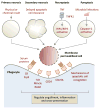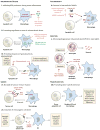Apoptotic cell clearance: basic biology and therapeutic potential
- PMID: 24481336
- PMCID: PMC4040260
- DOI: 10.1038/nri3607
Apoptotic cell clearance: basic biology and therapeutic potential
Abstract
The prompt removal of apoptotic cells by phagocytes is important for maintaining tissue homeostasis. The molecular and cellular events that underpin apoptotic cell recognition and uptake, and the subsequent biological responses, are increasingly better defined. The detection and disposal of apoptotic cells generally promote an anti-inflammatory response at the tissue level, as well as immunological tolerance. Consequently, defects in apoptotic cell clearance have been linked with various inflammatory diseases and autoimmunity. Conversely, under certain conditions, such as the killing of tumour cells by specific cell-death inducers, the recognition of apoptotic tumour cells can promote an immunogenic response and antitumour immunity. Here, we review the current understanding of the complex process of apoptotic cell clearance in physiology and pathology, and discuss how this knowledge could be harnessed for new therapeutic strategies.
Figures




References
-
- Wood W, et al. Mesenchymal cells engulf and clear apoptotic footplate cells in macrophageless PU.1 null mouse embryos. Development. 2000;127:5245–52. - PubMed
-
- Parnaik R, Raff MC, Scholes J. Differences between the clearance of apoptotic cells by professional and non-professional phagocytes. Curr Biol. 2000;10:857–60. - PubMed
-
- Monks J, Smith-Steinhart C, Kruk ER, Fadok VA, Henson PM. Epithelial cells remove apoptotic epithelial cells during post-lactation involution of the mouse mammary gland. Biol Reprod. 2008;78:586–94. - PubMed
Publication types
MeSH terms
Grants and funding
LinkOut - more resources
Full Text Sources
Other Literature Sources

